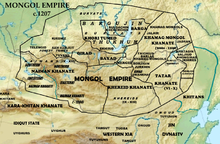Uriankhai
 Mongol Empire c 1207, Uriankhai and their neighbours | |
| Regions with significant populations | |
|---|---|
| 26,654 (2010 census)[1] | |
| Languages | |
| Oirat, Mongolian | |
| Religion | |
| Buddhism, Mongolian shamanism, Atheism | |
| Related ethnic groups | |
| Mongols, especially Oirats | |



Uriankhai (traditional Mongolian: ᠤᠷᠢᠶᠠᠩᠬᠠᠢ, Mongolian Cyrillic: урианхай; Yakut: урааҥхай; traditional Chinese: 烏梁海; simplified Chinese: 乌梁海; pinyin: Wūliánghǎi), Uriankhan (ᠤᠷᠢᠶᠠᠩᠬᠠᠨ, урианхан) or Uriankhat (ᠤᠷᠢᠶᠠᠩᠬᠠᠳ, урианхад), is a term of address applied by the Mongols to a group of forest peoples of the North, who include the Turkic-speaking Tuvans and Yakuts, while sometimes it is also applied to the Mongolian-speaking Altai Uriankhai. The Uriankhai included the western forest Uriankhai tribe and the Transbaikal Uriankhai tribe, with the former recorded in Chinese sources as Chinese: 兀良哈; pinyin: Wùliánghā). It is the origin of the Korean term "barbarian", 오랑캐.
History
The name "Uriankhai' means "uria" (motto, war motto) and khan (lord) in Mongolian. The Mongols applied the name to all the forest peoples and, later, to Tuvans. They were classified by the Mongols as Darligin Mongols.
At the beginning of the Mongol Empire (1206-1368), the Uriankhai were located in central Mongolia.
In 13th century
In the mid-14th century, they lived in
The second group of Uriankhai (Uriankhai of the
By the early 17th century the term Uriankhai was a general Mongolian term for all the dispersed bands to the northwest, whether
A variation of the name, Uraŋxai Sakha, was an old name for the Yakuts.[6] Russian Pavel Nebolsin documented the Urankhu clan of Volga Kalmyks in the 1850s.[7] The existence of the Uriankhai was documented by the Koreans, who called them by the borrowed name Orangkae (오랑캐, "savages"), especially in context of their attacks against the Siniticized world in the 14th and 15th centuries.[3]
Some Uriankhais still live in the Khentii Mountains.
The Taowen, Huligai, and Wodolian Jurchen tribes lived in the area of Heilongjiang in Yilan during the Yuan dynasty when it was part of Liaoyang province and governed as a circuit. These tribes became the Jianzhou Jurchens in the Ming dynasty and the Taowen and Wodolian were mostly real Jurchens. In the Jin dynasty, the Jin Jurchens did not regard themselves as the same ethnicity as the Hurka people who became the Huligai. Uriangqa was used as a name in the 1300s by Jurchen migrants in Korea from Ilantumen because the Uriangqa influenced the people at Ilantumen.[8][9][10] Bokujiang, Tuowulian, Woduolian, Huligai, Taowan separately made up 10,000 households and were the divisions used by the Yuan dynasty to govern the people along the Wusuli river and Songhua area.[11][12]
Notes
- ^ National Census 2010
- ^ ISBN 978-0816046713p.9
- ^ S2CID 143797249.
- ^ Willard J. Peterson, John King Fairbank, Denis Twitchett- The Cambridge History of China, vol7, p.158
- ^ A.Ochir, Ts.Baasandorj "Custom of the Oirat wedding". 2005
- ^ POPPE, Nicholas (1969). "Review of Menges "The Turkic Languages and Peoples"". Central Asiatic Journal. 12 (4): 330.
- ISBN 1-878986-04-X.
- ^ Chʻing-shih Wen-tʻi. Chʻing-shih wen-tʻi. 1983. p. 33.
- ^ Ch'ing-shih Wen-t'i. Ch'ing-shih wen-t'i. 1983. p. 33.
- ISBN 978-0-520-92884-8.
- ISBN 978-0-8351-1952-8.
- ISBN 978-83-7017-986-1.
